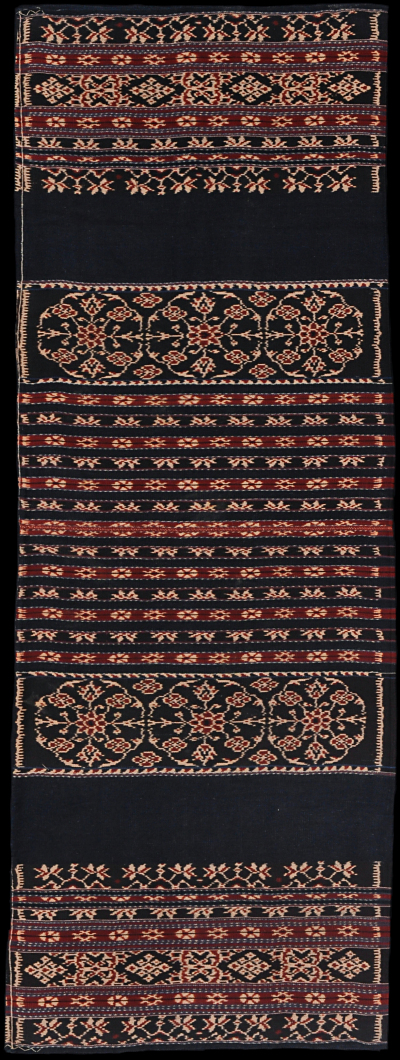| |
 
 | | | |
185 Savu Group, Savu
Ei (sarong)  
| | Locale: | Mesara, south Savu, Hubi Ae | | Period: | Before 1950 | | Yarn: | Cotton, ca. 99% hand-spun | | Technique: | Warp ikat | | Panels: | 2 | | Size: | 54 x 159 cm (1' 9" x 5' 2") LW: 2.94 | | Weight: | 505 g (17.8 oz), 294 g/m2 (0.96 oz/ft2) | | Design: | Sarong of a type called ei worapi hebe patola wore for bangsawan (nobility) of hubi ae, Bunga Palem Besar, Greater Blossom. Pattern locally called patola wore, prerogative of the nobility of Mesara. Perfect imitations of patola jilamprang patterns in the widest bands. The little zig-zag stitch at the top left corner is a bunga wurumada, a sign that the ceremony required after the weaving and before sewing the cloth into a sarong was completed. | | Comment: | Outstanding ikat work and very tight weaving. Very fine hand spun yarn, except a few accent stripes in white and burgundy, most only one (twined for volume) thread wide. The placement of the four small lozenges outside the circles creates two additional circular motifs consisting of six lozenges each. This visual effect, almost an illusion, is not unique but uncommon. One small hole, about the size of a fingertip in indigo background, hardly affecting the pattern. The cloth is supple, yet has the slighty rougher feel of hand spun cotton, markedly different from the buttery feel of Savu textiles made from commercial yarn, such as PC 009. Ex collection August Flick who visited Savu and bought many ikats. [Source GD.] | | Background: | Chapters on Savu Group and Savu. | | Exhibited: | Hong Kong University Museum and Art Gallery, 2017. | | Published: | Ikat Textiles of the Indonesian Archipelago, 2018.
| | Compare: | 009 028 255 | | Sources: | Nearly identical to sarong worn by family member of former district chief of Mesara, on photo in Maxwell, Textiles of Southeast Asia., Fig. 512. Very similar to sarong exhibited at Museum Tekstil, Jakarta, 2014, depicted in Duggan, Woven Stories, p. 71 top. Also very similar to sarong in Duggan, Ikats of Savu, Fig. 25, woven in Mesara, although that much younger piece is 'pagi sore', with motif patola on one end, and another motif on the other. But the end sections, lane wuru mada, are practically identical. Similar overall to sarong in Yoshimoto, Ikat, Fig. 149, except that the background of the patola motif here is indigo rather than brick red. Similar to sarong in De Jong and Kunz, Mustergültig, Abb. 25, but with much greater definition. Ex collection August Flick. | | |

©Peter ten Hoopen, 2025
All rights reserved.
|
|


